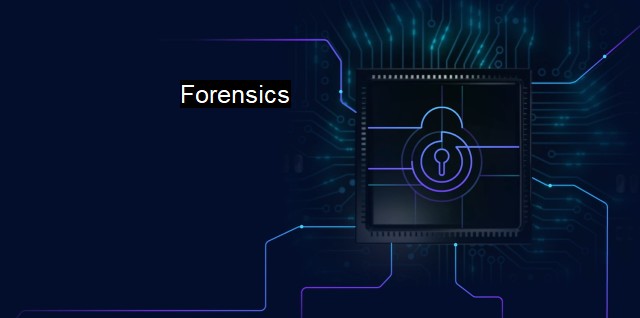What are Forensics?
Computing Security: The Vital Role of Forensics, Antivirus and Cybersecurity in Countering the Escalating Threat of Cybercrime
Forensic science, often referred to merely as forensics, has become synonymous with crime investigation helped by popular television dramas showing investigators uncovering vital evidence that helps bring the guilty to justice. forensics isn't exclusively limited to crime scenes or pathology labs. the discipline of forensics plays an equally critical role, typically known as digital forensics or cyber forensics.Digital forensics is the process of identifying, collecting, analyzing, and preserving digital evidence to establish a sequence of events to understand the nature of an incident. It's like solving a puzzle by fitting the pieces together to get the bigger picture. As any empirical science, every piece put together must maintain its authenticity and reliability without any manipulation or distortion. The motivation behind this is to determine the source, nature, scope, and impact of a security incident, such as a malware attack, security breach, data theft or even an insider threat.
This field came about as a response to the escalation of crimes committed using computers and the internet. Cybercriminals began using sophisticated techniques to compromise systems, propagate malicious viruses, and breach data. Antivirus software was developed to counter these threats. they aren't bulletproof and sometimes fail to detect new or advanced forms of malware, necessitating the need for digital forensics to step in and dissect the incident.
There are multiple facets to digital forensics depending upon the nature and source of the cyber incident. Some of the primary branches include, network forensics, which involves monitoring and analyzing computer network traffic. Database forensics, which focuses on databases and their related metadata. Cloud forensics, a cross-discipline field that encompasses both network and software forensics to examine data from the cloud. Similarly, disk and data forensics focuses on computers and generic data storage units to recover hidden, deleted or lost data.
In addition to identifying and analyzing digital evidence, the primary purpose of digital forensics experts is to create a documented trail of the incident that stands up in court, should the cybersecurity breach escalate into a legal dispute. This requires careful and meticulous handling of evidence to maintain its integrity for judicial procedures.
Forensic investigators use specialized and often proprietary software to perform tasks such as creating an exact copy of the hard drive (called disk imaging), tracking and extracting web history, or recovering deleted or encrypted files. These tasks further allow investigators to carry out deeper forensic analysis such as timeline analysis (events that took place leading to and following the cybercrime), correlation engine (linking different digital evidence to create a storyline), live forensics or volatile memory analysis, which involves analyzing data that gets lost when the machine is switched off, like running processes and network connections.
In the context of antivirus landscapes, forensics plays a decisive role in understanding how a new virus or malware operates, its point of origin, possible backdoors in the system, and eventually work towards producing an antivirus signature, entering it into a database so future instances are automatically blocked. A fuller understanding of the malware also facilitates building more robust systems and strategies to combat similar issues in the future.
Thus, digital forensics embodies an interplay of methods, tools, ethics, and investigative processes to understand security incidents. It proves that no cybercrime is perpetrated without leaving a digital fingerprint. By collecting these fingerprints, digital forensics provides a responsive platform to disclose the reality behind every breach, providing a cloak of assurance in the uncertain world of the internet, further strengthening the claim that forensics is not just limited to the traditional domains of science but also empowers cybersecurity and antivirus initiatives in combating digital threats.

Forensics FAQs
What is digital forensics?
Digital forensics involves the collection, preservation, analysis, and presentation of electronic evidence in a manner that is admissible in court. It is commonly used in investigations related to cybersecurity and antivirus incidents.What are the different types of forensic analysis that can be performed on a computer?
There are several types of forensic analysis that can be performed on a computer including file analysis, memory analysis, network analysis, and malware analysis. Each type of analysis provides different types of information about the system and can be used to identify potential security threats.What is the role of forensics in cybersecurity?
Forensics plays a critical role in cybersecurity by helping to identify the source and extent of a security incident. This information can be used to develop and refine security strategies to prevent similar incidents in the future. Digital forensics can also provide evidence that can be used in legal proceedings related to cybersecurity incidents.How can antivirus software benefit from using digital forensics?
Antivirus software can benefit from using digital forensics by identifying new types of malware and developing more effective ways to detect and remove them. By analyzing the behavior of malware, antivirus software developers can gain insight into how it works and develop more robust detection and removal techniques. Digital forensics can also be used to investigate incidents where antivirus software may have failed to detect or remove malware.Related Topics
Malware analysis Digital forensics Network forensics Memory forensics Mobile device forensics
| | A | | | B | | | C | | | D | | | E | | | F | | | G | | | H | | | I | | | J | | | K | | | L | | | M | |
| | N | | | O | | | P | | | Q | | | R | | | S | | | T | | | U | | | V | | | W | | | X | | | Y | | | Z | |
| | 1 | | | 2 | | | 3 | | | 4 | | | 7 | | | 8 | | |||||||